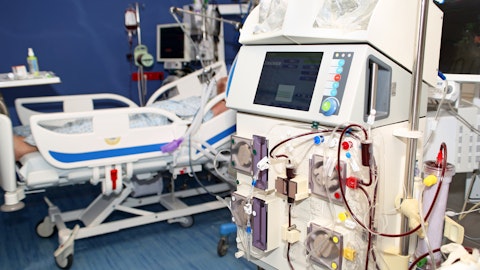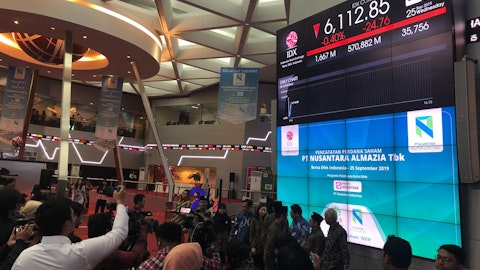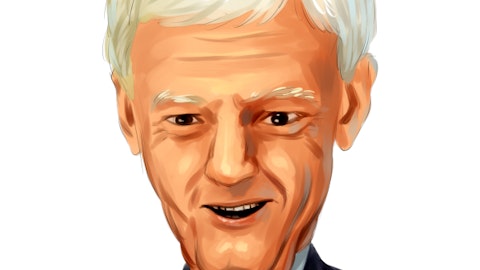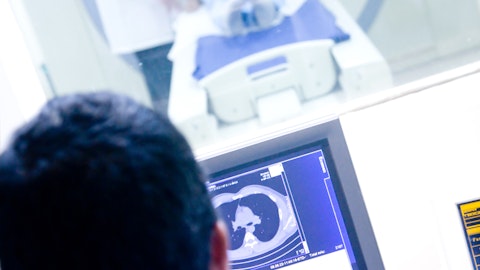Joanne Wuensch: Thank you.
Peter Arduini: Sure.
Operator: Thank you. Our next question comes from Anthony Petrone with Mizuho. Your line is open.
Peter Arduini: Good morning, Anthony
Anthony Petrone: Good afternoon, Pet. Good morning, Jay. Congrats on another strong quarter here. I think I’ll stay on the 2024 theme and maybe just to level set where the backlog conversion to forward revenues sort of sits on maybe an 18-month go-forward basis. So as we look at the ending backlog is it – should we be thinking that it’s feasible that 60% of the backlog can be converted over the next 18 months? And are there any areas where that backlog conversion possibly got extended. We heard some competitors talking about elongated cycles for instance in China. And I’ll have a quick follow-up for Jay on margins.
Peter Arduini: Yes Anthony, I would say when we think about our backlog we actually felt it’s quite solid. I mentioned that it was $18 and change – $18.4 billion. With book-to-bill you know how the math works as we actually are having a book-to-bill that’s positive meaning that it’s actually more orders are going in than revenues going out. We’ll start next year with a backlog that’s pretty close to where we are today which is super healthy. And it’s about $1 billion above where we were pre-COVID. So that gives you plenty of gas in the tank to be able to continue to drive revenue. And again with this business that can be lumpy on the orders front that’s an important dynamic. I mentioned in China. I know there’s been a lot of different news from different companies.
We obviously felt the effects of the China anticorruption earlier about customers disengaging at some level but as that reintegrated in later in the quarter obviously, we put up good numbers with being able to outperform the previous year. The only other comment I would say relative to Q3 in the US towards the end of the quarter we did see some longer deals taking a little bit longer. And as you kind of peel the onion back on that what it really is about is that some customers are seeing some higher project costs more on the labor and construction side for install compared to their initial budgets. And so the deals are getting done for sure. But what that means is they may have to go back to their finance committee and say “Hey this is going to be $100000 more and actually get another approval”.
And so I think that works its way through the systems as those estimates and the actual cost match up in the coming quarters. But that’s probably the only thing we’ve seen that has kind of played out on the time horizon.
Anthony Petrone: Very helpful. And quickly Jay just on the implied 4Q earnings would be $0.09 midpoint is up by $0.02 for 4Q. So just anything of note and as we look into the back end of the year here for the margin trajectory? And if there are any headwinds that we’re seeing do those potentially slip into the first half of 2024. Again thanks and congratulations.
Jay Saccaro: Yes. Thank you – thanks for the question and the comment. Overall, we’re pleased with the performance year-to-date. I think what we’ve seen across the board is the resiliency of the portfolio continued focus on margin execution. I think all the key ingredients are in place. By the way I would also point out very strong free cash flow performance in the third quarter, which is an intense area of focus for us. So I feel very good about what we delivered in the third quarter. As we move to the fourth quarter the probability – our confidence in our ability to achieve the full year outlook has definitely increased. We raised the low end by $0.05 which implies $0.025. We don’t really have material changes to the fourth quarter outlook.
We feel solid about that. I would point out that there were a couple of cents of FX. The way our FX forecast worked out and the subsequent rate moves we had a bit of favorability in EBIT in the third quarter related to foreign exchange a couple of cents. And then the fourth quarter is a couple of cents lighter than the forecast we put together. That’s the most noteworthy item. Other than that I think we’re going to focus on continued execution in the fourth quarter and setting ourselves up for a successful 2024.
Anthony Petrone: Thank you.
Operator: Thank you. Our next question comes from Patrick Wood with Morgan Stanley. Your line is open.
Patrick Wood: Amazing. Thanks for taking the question. I mean taking a step back historically, it was tough to get paid for innovation. You have the slice wars and then you add Freelium and it was always kind of difficult to get price. But today, you guys did a great job in taking price mix on some of the recent innovations. I guess my question is like what do you think has changed? Is it just that the scope of innovation happening today is higher? And how should we interpret that so how you’re thinking about pricing for photon counting longer-term? Thanks.
Peter Arduini: Yeah, Patrick good question. Look, I think it’s a convergence of many different things. Obviously, with the higher cost that took place during the COVID window sometimes that’s a necessity for all to kind of reflect on your pricing strategies and where you are. And so I think that’s some level of a beginning catalyst. It’s been a really important part of our kind of strategy as a company to talk about that we want to be paid fairly for what we come up with. I think when you look at the ROI on many of the products we make they pay for themselves in months not years. And many of these products are held for seven to eight years. So the return on investment whether you’re paying 2% money or 8% money, is still very, very good.
And I think that’s part of it. And getting the confidence in your commercial teams that that’s the reality and how to sell that value I think that’s been part of it. The other aspect is innovation investments. If you’re innovating and coming out with something every three to five years, versus something new every 18 months that you can actually ask a little bit more for, because it actually creates more value that also brings price up. And that’s an important part of our strategy. But at the end of the day, we have to demonstrate that we bring more value for customers and show that the returns are there. And I think things such on the digital side and artificial intelligence that can actually reduce workflow issues. It can actually take work out of the system, and actually can treat more patients is a winner.
We talked about Air Recon DL. You have a 10-year-old product. We do an upgrade. We actually ask a reasonable value for that that’s higher margin than we would typically get on just a hardware alone. And you get a 50% increase in throughput and we also take your capabilities to state-of-the-art. Those are the kind of things that we’re excited about. And I think more of the software applications and capabilities we have coming forward are going to deliver on that.
Patrick Wood : Got it. Just as a very quick follow-up. Are you seeing anything notable on spec. I mean, like maybe with some of the bundled deals a higher proportion of free Tesla or like anything on the spec across the different modalities.
Peter Arduini: When you say spec you’re talking about different specifications on the modalities changes?
Patrick Wood: Yeah, because obviously not every MR and CT scanners equivalent. And obviously, with — especially with some of the bundled deals I’m curious as to how people are bundling purchasing and less direct pricing or the systems themselves that they’re buying within those?




